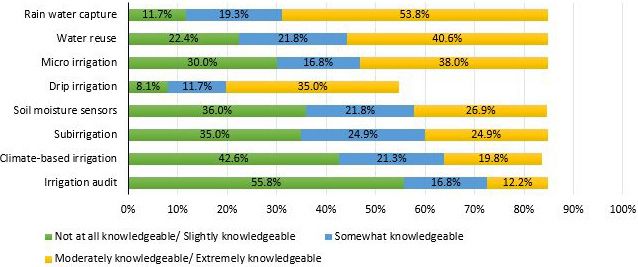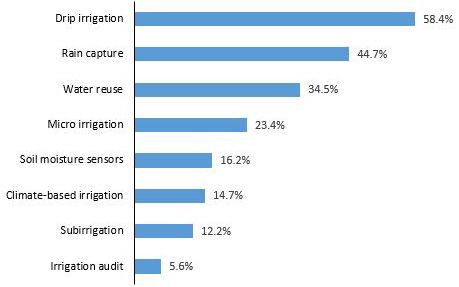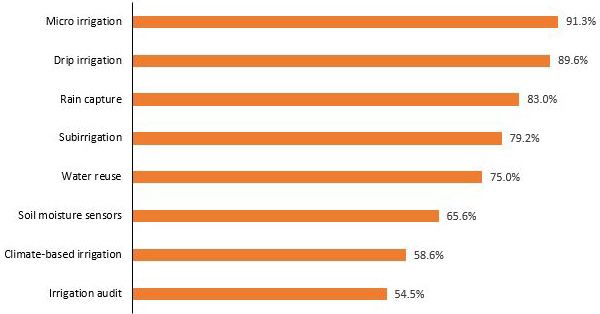Abstract
Nursery and greenhouse growers comprise an important sector of United States agriculture that is uniquely situated to conserve water while growing plants that provide many social and environmental benefits. In order for Extension professionals to effectively help growers use water conservation technologies, it is important to understand the knowledge level and adoption rates growers have surrounding different water conservation techniques. It is also important to understand how grower perceptions of water conservation strategies relate to their adoption. In this publication, we present results of a study designed to understand the knowledge level, adoption rate, and levels of continuance associated with eight water conservation technologies among nursery and greenhouse growers. We also examined whether five characteristics of these technologies (trialability, complexity, compatibility, relative advantage, and observability) predicted grower adoption. This information is intended for use by Extension professionals and others who serve the nursery and greenhouse grower audience, and especially those who work in water conservation.
Introduction
A major focus among many US Extension systems across the country is enhancing and protecting water quality, quantity, and supply (CU, 2015; UF/IFAS, 2013; UGA/CAES, 2012). For this reason, Extension professionals work with different groups, such as nursery and greenhouse growers, to share new water conservation strategies, or innovations (Fulcher et al., 2012). An innovation is considered something new to a group of people or an individual, and diffusion is the process of the individual or group communicating about the innovation (Rogers, 2003). In our study, we considered a number of water conservation technologies that could be considered innovations among nursery and greenhouse growers (Yeary et al., 2016). The innovations under study were:
- rainwater capture (collecting rainwater to use for irrigation);
- water reuse (saving excess irrigation water to reapply to crops);
- microirrigation (applying small amounts of water to the growing substrate and plant roots, often with limited coverage drip and spray emitters);
- drip irrigation (a type of microirrigation where low-flow emitters apply water directly to plant roots);
- subirrigation (ebb-and-flood irrigation delivery from below the container, usually combined with a tank to hold water)
- soil moisture sensors (controlling irrigation events based on substrate moisture threshold levels);
- climate-based irrigation (timing of irrigation using evapotranspiration models and sensors of temperature, relative humidity, light, and/or precipitation); and
- irrigation audits (evaluation of irrigation equipment efficiency and uniformity).
Extension professionals need to be able to elicit behavior change to deliver successful Extension programs (Harder, 2009; Warner et al., 2014). However, encouraging people to change is a complex and multi-staged process. The concept of diffusion integrates the stages people move through when deciding whether to adopt something new (an innovation), as well as characteristics of the innovation itself (Rogers, 2003). Extension programs can better meet the needs of clientele when they integrate these stages as well as the audience perception of technology characteristics (Harder, 2009).
When considering a new idea or technology, people can move through different stages:
- learning about an innovation;
- developing an opinion about the innovation;
- deciding whether or not to adopt the innovation;
- implementing the innovation; and
- confirming whether they are satisfied with their decision.
During this last stage, someone who adopted an innovation but was unsatisfied might choose to discontinue its use. It is important for Extension professionals to help their clientele to learn about, form positive opinions of, adopt, and continue to use appropriate conservation strategies. Applied to our context, we wanted to inform Extension programming by evaluating how knowledgeable growers considered they were about the eight innovations listed above. We also wanted to understand what innovations had been adopted and which had continued use. Additionally, we wanted to understand how growers perceived characteristics of these innovations.
The five perceived characteristics of innovations include:
- trialability,
- complexity,
- compatibility,
- relative advantage, and
- observability (Rogers, 2003).
Nursery and greenhouse growers who perceive water conservation technologies to have positive characteristics (available to try out, easy to use, compatible with their values and operations, better than technologies they currently or previously used, and having benefits that are available to observe) are more likely to adopt an innovation and continue its use at their operation. For more information about diffusing behaviors, visit Planned Behavior Change: An Overview of the Diffusion of Innovations, at https://edis.ifas.ufl.edu/publication/WC089.
Measuring US Nursery Growers' Knowledge, Adoption, and Continued Use of Water Conservation Technologies
We collected data using web- and paper-based versions of a survey during the first half of 2017. We worked with a team of Extension and research professionals to distribute electronic surveys to their clientele using their email contact lists and paper surveys during various speaking engagements. We received completed responses from 192 growers representing 31 states. Further details about the methods used for this research are available in the corresponding journal article.
To identify knowledge level, we asked the growers to rate their knowledge with each of the eight technologies on a scale from 1 (not at all knowledgeable) to 5 (extremely knowledgeable). To identify adoption, we used a check-all-that-apply question along with the same list of eight technologies. To identify continuance, we asked growers to say whether they were still using any of the conservation technologies they checked in the previous question.
To measure trialability, we asked the growers to indicate how much they agreed or disagreed with statements such as: water conservation technologies are readily available to test before being installed. To measure complexity, we provided growers with five sets of adjectives, such as confusing to straightforward, and asked them to select one of five points between that most closely corresponded to their feelings. To measure compatibility, we asked the growers to indicate how much they agreed or disagreed with statements such as: water conservation technologies are easy to implement into existing facilities. To measure relative advantage, we asked the growers to indicate how much they agreed or disagreed that: current water conservation technologies are better than what I have used in the past. To measure observability, we asked questions that included: how likely are you to adopt the new water conservation technologies or practices you observed someone else using?
Findings
Findings: Knowledge
Growers reported having the highest levels of knowledge for rainwater capture, water reuse, and microirrigation (Figure 1). The lowest levels of reported knowledge were for irrigation audits, climate-based irrigation, and subirrigation.

Findings: Adoption
The water conservation technologies adopted at the highest rates were drip irrigation, rainwater capture, water reuse, and microirrigation (Figure 2). These top four water conservation technologies correspond to those with which growers reported the greatest level of knowledge. The growers indicated they were least likely to have adopted irrigation audits, subirrigation, or climate-based irrigation; the technologies for which the growers reported the least knowledge.

Findings: Continued Use
The growers who had adopted any of the eight water conservation strategies indicated whether those specific technologies were still in use (Figure 3). More than half of the growers who had adopted each of the individual technologies were still using them, and the rate ranged from about half (irrigation audits) to about nine out of ten growers still using a technology they had previously adopted. Microirrigation, drip irrigation, and rainwater capture were most likely to still be used. These three technologies were among the top four technologies with which growers reported highest knowledge, and the top four most likely to have been adopted. The growers reported they were least likely to still use irrigation audits and climate-based irrigation.

Findings: Perceptions of Innovations Influencing Adoption
Trialability, relative advantage, and observability all significantly predicted growers' adoption of the eight water conservation technologies, but compatibility and complexity did not predict adoption. We think this may be because water conservation technologies have improved substantially and have been available to nursery and greenhouse growers for some time.
How to Use this Information
The findings presented above reveal that:
- Knowledge levels with specific technologies are highly variable.
- Higher levels of knowledge with specific technologies generally correspond to greater adoption.
- Higher levels of adoption of specific technologies generally correspond to greater continued use.
- Continued use of technologies is fairly high once a grower has adopted an innovation.
- Growers are more likely to adopt specific water conservation technologies if they perceive one or more of the following: the technologies are available to try out, better than what they have done and/or used in the past, or when their benefits can be observed.
Extension professionals can use these findings to design Extension programs that meet the needs of nursery and greenhouse growers. We offer the following insights and recommendations:
- To encourage adoption, target those conservation technologies with low levels of knowledge and adoption, such as irrigation audits and climate-based irrigation.
- Provide extra support for those technologies that have a lower continued use rate after adoption, such as irrigation audits, climate-based irrigation, and soil-moisture sensors.
- Provide opportunities for nursery and greenhouse growers to try out water conservation technologies and observe their benefits.
- Ensure the water conservation technologies shared with growers are compatible with their operations and values, and help growers to recognize this compatibility.
- Make sure educational materials are straightforward and communicate the ease of using specific technologies. When technologies are somewhat difficult to use, design programs that simplify their operation as much as possible.
Conclusions
The findings of this study illustrate how the concept of diffusion, and specifically how stages in the adoption process and characteristics of innovations relate to adoption of technologies for nursery and greenhouse water conservation. There is an opportunity to aid in developing positive perceptions of the water conservation technologies available to growers. There is also an opportunity to make technologies available on a trial basis. Finally, there is an opportunity to provide support for growers who have adopted these technologies to help guide experiences that are positive and ultimately result in continued use.
Acknowledgements
This publication was designed by Clean WateR3, a federally funded Specialty Crops Research Initiative grant focused on research and outreach to help growers Reduce, Remediate, and Recycle irrigation water. This project was supported by the National Institute of Food and Agriculture, US Department of Agriculture, under award number 2014-51181-22372.
More Information
For more information about this study and for additional resources on reducing, remediating, and recycling nursery and greenhouse irrigation water, please visit https://www.cleanwater3.org.
References
Clemson University [CU]. (2015). Clemson Cooperative Extension Strategic Plan 2015—2020. Retrieved from https://www.clemson.edu/extension/strategicplan/
Fulcher, A., Klingeman, W. E., Chong, J., LeBude, A., Armel, G. R., Chappell, M. & Windham, A. (2012). Stakeholder vision of future direction and strategies for southeastern U.S. nursery pest research and extension programming. Journal of Integrated Pest Management, 3(2), D1–D8. https://doi.org/10.1603/IPM11030
Harder, A. (2009). Planned behavior change: An overview of the diffusion of innovations. WC089. Gainesville: University of Florida Institute of Food and Agricultural Sciences. https://edis.ifas.ufl.edu/publication/WC089
Rogers, E. M. (2003). Diffusion of innovations (3rd ed.). New York, NY: Free Press.
University of Florida Institute of Food and Agricultural Sciences [UF/IFAS]. (2013). Shaping solutions for Florida's future: The University of Florida extension roadmap 2013—2023. Retrieved from https://pdec.ifas.ufl.edu/roadmap/FloridaExtensionRoadmap_2013-2023.pdf
University of Georgia College of Agriculture and Environmental Sciences [UGA/CAES]. (2012). 2020 Strategic plan: Version 2.0. Accessed August 17, 2022. Retrieved from https://www.caes.uga.edu/content/dam/caes-website/office-of-diversity-affairs/documents/Version%202.0%20CAES%20strategic%20plan-FINAL.pdf
Warner, L. A., Galindo, S., & Gutter, M. (2014). Building impactful Extension programs by understanding how people change. AEC527. Gainesville: University of Florida Institute of Food and Agricultural Sciences. https://edis.ifas.ufl.edu/publication/WC189
Warner, L. A., Lamm, A. J., Beattie, P., White, S. A., & Fisher, P. (2018). Identifying opportunities to promote water conservation practices among nursery and greenhouse growers. HortScience, 53(7), 958–962. https://doi.org/10.21273/HORTSCI12906-18
Yeary, W., Fulcher, A., & Leib, B. (2016). Nursery irrigation: A guide for reducing risk and improving production. Retrieved from https://extension.tennessee.edu/publications/Documents/PB1836.pdf